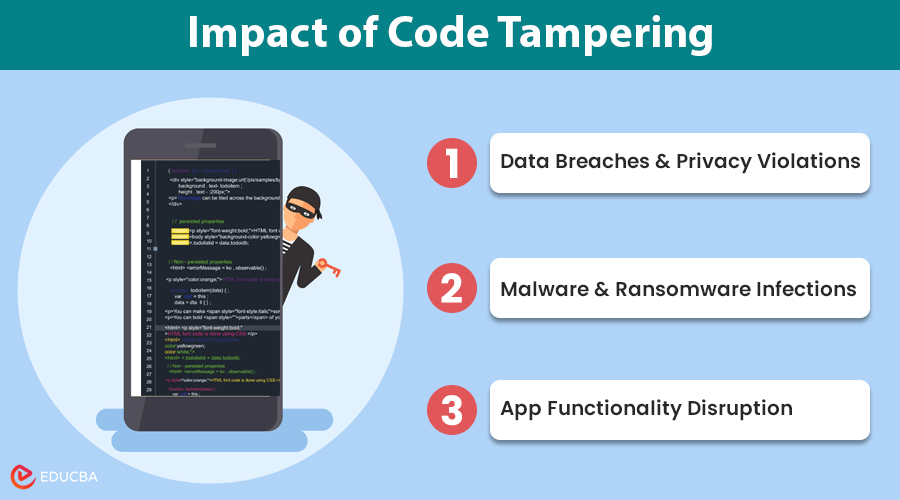
What is Code Tampering?
Code tampering happens when attackers modify a mobile app’s code after its release. They exploit weaknesses to gain unauthorized access, steal data, or cause the app to malfunction. This can lead to several security risks that affect both users and developers.
Let’s discuss how it impacts mobile application security and how to prevent it.
Impact of Code Tampering
Code tampering is not just a technical issue. It has real-world consequences that can hurt users and developers in the following ways:
1. Data Breaches and Privacy Violations
One of the most enormous risks of this tampering is statistical breaches and privacy violations. Tampered code may be used to steal sensitive user statistics, inclusive login credentials, credit card records, or personally identifiable information (PII).
This can lead to:
- Financial losses for users and developers.
- Reputational damage for the app developer.
- Legal liabilities if user data is stolen.
Moreover, it can also violate consumer privacy. For example, an attacker might use tampered code to gain access to a consumer’s location data, contacts, or other sensitive information without their consent.
2. Malware and Ransomware Infections
Tampered code can be used to inject malware or ransomware into the app.
Attackers can:
- Steal sensitive data.
- Block access to user information and demand payment (ransomware).
- Cause significant financial and legal issues for both users and developers.
Ransomware attacks happen when malicious code is used to encrypt a user’s data, and the attacker demands payment to provide the decryption key.
This can permit attackers to:
- Demand payment as an alternative to restoring the right of entry to the information.
- Steal sensitive user data.
- Disrupt app functionality.
Such infections can lead to financial losses, damage to the company’s reputation, legal consequences, and a loss of trust in both the app and its developer.
3. App Functionality Disruption
App capability disruption takes place when malware or ransomware infections compromise an app’s ordinary operation, leading to several terrible outcomes.
Tampered code can make an app unstable. This leads to:
- Performance problems such as freezing, crashing, or slowdown.
- Regulation or deletion of important app statistics, causing errors, inconsistencies, or a lack of capability.
- Loss of trust among users, causing negative reviews and uninstalls.
- Denial of Service (DoS) attacks, where the app becomes unavailable.
How to Prevent Code Tampering?
App developers need to implement strong security practices to prevent code tampering. Here are some ways to reduce the risks:
1. Encryption
Encrypt the code and sensitive data to make it unreadable to attackers. Even if they access the data, encryption ensures that they cannot use it.
2. Secure Development Environment
Develop your app in a secure environment. This prevents unauthorized access to the code during development and reduces the chance of tampering before the app is released.
3. Regular Updates and Patching
Regularly update the app to fix any known vulnerabilities. Patching security holes makes it harder for attackers to tamper with the code.
4. Code Review and Testing
Conduct regular code reviews and security testing. This helps identify weaknesses before attackers can exploit them. Frequent testing reduces the chances of overlooking any vulnerabilities.
5. Monitor for Suspicious Activity
Keep track of any unusual behavior in your app. Monitoring tools can detect potential tampering attempts and warn developers before any damage occurs.
How Code Tampering Affects Developers?
For developers, it can lead to:
- Loss of user trust: When users encounter security issues, they lose confidence in the app.
- Reputational damage: Poor security practices can hurt the company’s image, especially for apps that rely on user data.
- Legal consequences: If sensitive user data is stolen, the developer could face legal actions.
Why Is Code Tampering Dangerous for Users?
This tampering doesn’t just affect the developer; it directly impacts users. Here are the dangers:
- Stolen personal information: Tampered apps can steal login credentials, payment details, and other private data.
- Malware: Users may unknowingly download an app infected with malware.
- Loss of app functionality: A tampered app might not work properly, causing user frustration.
Final Thoughts
Code tampering has vast effects on mobile application security. It can result in data breaches, privacy violations, reputation damage, and legal liabilities. It is consequently essential for app developers to take proactive measures. By doing so, app builders can guard user statistics and prevent economic losses.
Recommended Articles
If you found this article on ‘Code Tampering‘ interesting, you can also check the suggestions below:

